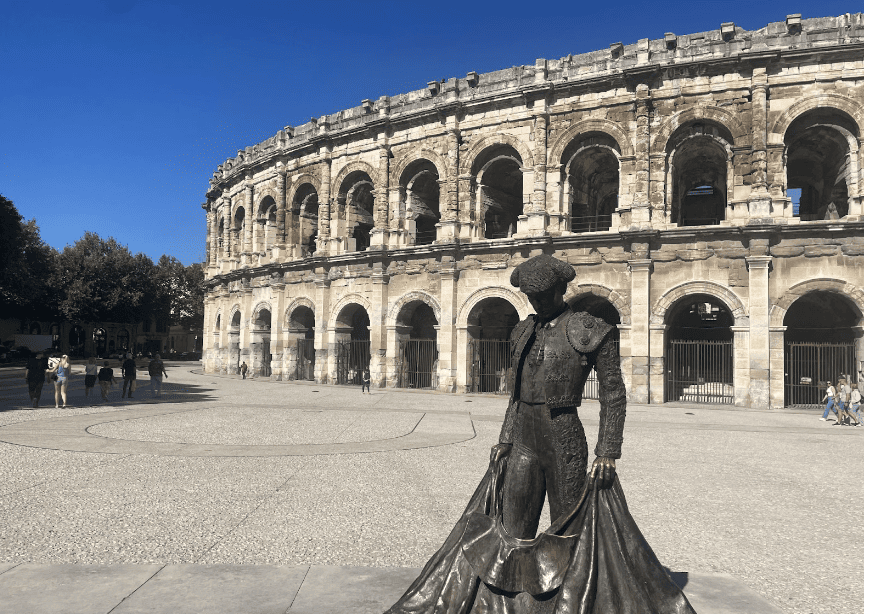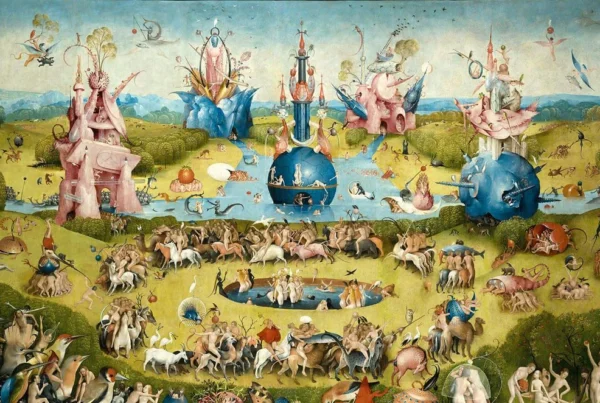Featuring all things classic in “La Rome Française”
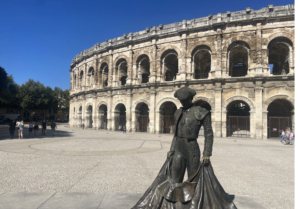
The Journey
A visit to Nimes is a perfect weekend trip by either train or bus. After my Friday class, I took the 19:45 bus from Reims to Paris and then the midnight bus from Paris to Montpellier, which lasted 10 hours. After arriving in Montpellier, I took a quick TER train to Nimes and arrived at 11:00. I did the same trip through Montpellier and Paris to Reims on my way back Sunday night.
The Stay
I stayed at Hotel Vertigo Nîmes Centre Gare, a hostel that, despite its location just adjacent to the train station, was quite overpriced. There aren’t many affordable options in the city, though, so Hotel Vertigo is most likely your best bet. A bunk in a shared room starts at 35€.
If you are traveling with friends or willing to spend more, the Ibis budget Nîmes Centre Gare or Kyriad Nîmes Centre offer double rooms for around 60€.
The Food
Nîmes’s culinary scene is a blend of Mediterranean seafood and olive oil, along with vibrant vegetables and local treats sold at the city’s covered market, Les Halles de Nîmes. The market is worth a visit for travelers of all budgets to taste a bit of Pélardon, a local goat cheese, or pâté nîmois, a small pastry resembling a bouchon filled with pork and veal pâté. 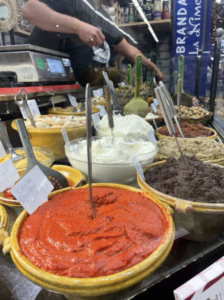
While I did not visit many sit-down restaurants in Nimes, a trip to Le Napoléon will surely transport you back to the era of Louis Napoleon with its flashy 19th-century interior. You can also explore the city’s Italian food options, including a counter-service place i Fratelli, whose window display of arancini and pizza al taglio immediately drew me in. For some more handheld delights, walk up to the intimate Place des Esclafidous and grab an empanada at Che Boludo Empanadas Argentinas. Alternatively, GAMEL Restaurant at the other end of the plaza serves modern creations born out of the region’s terroir, including a butternut squash soup with wild mushrooms and margret de canard topped with quince puree and fig.
Lounge
Nîmes’s center is rich in plazas and cafes, great for pastries and people-watching. Bar des Beaux-Arts offers a panoramic view of the action outside of the Cathédrale Notre-Dame-et-Saint-Castor de Nîmes (a verbal marathon). Other cafes at Place du Marché surround a tall palm tree and the Fontaine du Crocodile, a tribute to the city’s Roman-era emblem of an enchained crocodile.
See
Of course, one could not visit Nîmes without encountering some of the stone remnants of Roman times. The astonishingly well-preserved Arène de Nîmes is among the first things to greet you upon entering the city. The limestone arena dates back to the 1st century AD and serves as a time capsule to an era of gladiator combat, theatre and public executions. The Arena offers an audio guide for those interested in a dramatic interview with a “real life” gladiator Aptus from 139 CE.
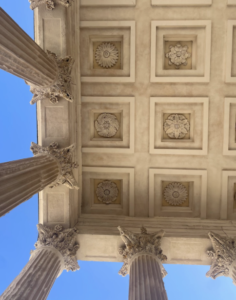 One can also see the Maison Carrée, arguably the best-preserved surviving Roman temple. This temple joined the UNESCO World Heritage List in just September of this year, and for a good reason. The temple, raised up almost three meters by its podium, was a central part of the city’s forum when Nîmes was Nemausus.
One can also see the Maison Carrée, arguably the best-preserved surviving Roman temple. This temple joined the UNESCO World Heritage List in just September of this year, and for a good reason. The temple, raised up almost three meters by its podium, was a central part of the city’s forum when Nîmes was Nemausus.
A stroll through the Jardins de la Fontaine is essential. This was one of the first public parks in Europe and opened in 1745 after the ruins of a previous Roman park at the site were discovered. Here, canals and pools weave through walkways lined with statues. Also in the park are the ruins of the Temple of Diana, which had most likely been used as a place of worship.
Finally, a strenuous walk up the park’s winding paths lined with large succulents will lead you to the Tour Magne, a dignified last vestige of the city’s 6 km of stone walls built in 38 BCE. From 32 meters up, the panorama of the city provides a place for reflection on our relationship to
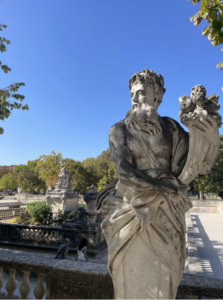 Roman times. While Roman ruins are persistently maintained to maintain ties with the past, the influence of the Roman Empire has also inspired more modern works. Montpellier’s Aqueduc Saint-Clément, built in 1766, and designed by Henri Pitot, drew directly from the legacy of the region’s Pont du Gard.
Roman times. While Roman ruins are persistently maintained to maintain ties with the past, the influence of the Roman Empire has also inspired more modern works. Montpellier’s Aqueduc Saint-Clément, built in 1766, and designed by Henri Pitot, drew directly from the legacy of the region’s Pont du Gard.
In a city of just one hundred fifty thousand inhabitants, there are countless opportunities to remember Roman times, and perhaps with good reason. Nîmes’ Musée de la Romanité, which opened just 5 years ago, could be described as a temple dedicated to the city’s Roman legacy in the city. Its marble statues and well-preserved mosaics whisk us away to an era of trailblazing infrastructure, legal systems, and culture.
This pioneering spirit deserves to be remembered, but the Empire’s legacy of imperialism, slavery, and cultural subjugation should not reciprocally be forgotten. We can learn from both the revolutionary and the more sinister impressions left in Roman times. And if school has got you tired of history, that’s no problem. Just sit back, relax, and gaze at the stone from afar.
Want to soak up the last rays of sun before winter cold kicks in? Nîmes, in the Occitanie region of France, combines well-preserved Roman ruins with a laid-back vibe, perfect for pastis and people-watching.
Other posts that may interest you:
- Insight into the Warwick Economics Summit: A Discussion on the UK’s Economic System with Sir Howard Davies
- La grève des scénaristes et des acteurs: Hollywood en péril ?
- A forbidden fruit — nourished in shadows,
- Paris, December 21
- At your mercy at the coffee shop
Discover more from The Sundial Press
Subscribe to get the latest posts sent to your email.


